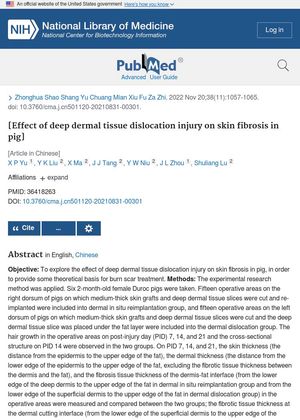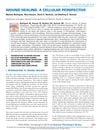Effect of Deep Dermal Tissue Dislocation Injury on Skin Fibrosis in Pigs
November 2022
in “
PubMed
”

TLDR Deep dermal tissue dislocation injury in pigs leads to thicker fibrotic tissue and increased type III collagen, affecting skin repair.
The study investigated the impact of deep dermal tissue dislocation injury on skin fibrosis in pigs, with implications for burn scar treatment. Six 2-month-old female Duroc pigs were used, with 15 operative areas on each pig's right and left dorsum, forming two groups: dermal in situ reimplantation and dermal dislocation. Observations were made on post-injury days (PID) 7, 14, and 21. The results showed that hair growth was denser in the dermal in situ reimplantation group, and skin structure remained normal compared to the "sandwich"-like structure in the dermal dislocation group. Skin thickness was similar between groups, but dermal thickness was significantly thinner and fibrotic tissue thickness at the dermal-fat interface was significantly thicker in the dermal dislocation group. Type III collagen content was significantly increased in the dermal dislocation group, while no significant differences were found in type I collagen content between groups. Positive expressions of PCNA, TGF-β1, FGF-2, and HGF were found in both groups, with a wider distribution in the dermal in situ reimplantation group. The study concluded that inadequate intrinsic thickness of dermal tissue is a key factor in fibrosis, which serves to compensate for the skin's intrinsic thickness, and that adipose tissue may play an important role in fibrotic skin repair.
